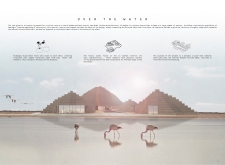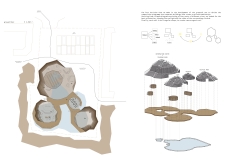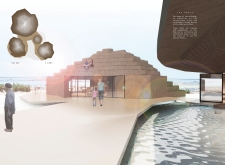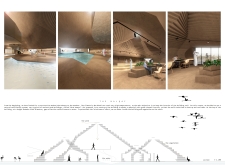5 key facts about this project
The center consists of several interconnected structures that collectively form a cohesive architectural entity. Each structure is carefully crafted to interact with the landscape while providing specific functions such as educational exhibits, a café, and spaces for community engagement. The design emphasizes sustainability by utilizing local materials and traditional construction techniques, ensuring that the project aligns with its ecological context.
Design Approach and Environmental Integration
A key distinguishing feature of this project is its inspiration drawn from local natural forms, particularly the nesting patterns of flamingos and the character of fossil dunes in the reserve. The organic shapes of the buildings mimic these natural elements, creating an architectural dialogue with the surroundings. This approach emphasizes the importance of context in architectural design, grounding the visitor experience in the unique ecological and geographical narrative of the wetlands.
The incorporation of sustainable materials, such as adobe, significantly contributes to the building's thermal performance. This choice reflects an understanding of the regional climate, allowing for passive cooling and energy efficiency. Additionally, the use of glass in key areas enhances the connection between the interior spaces and the external landscape, inviting natural light while providing uninterrupted views of the natural habitat.
Functional Design and Educational Importance
The design facilitates various educational and recreational functions. The visitor center includes spaces for informative displays about local wildlife and conservation efforts, training rooms for community workshops, and interactive areas where visitors can engage with the environment. The layout of the structures encourages exploration, with pathways connecting the different sections to promote a sense of discovery.
Furthermore, innovative features such as wind towers and water management systems illustrate the project's commitment to environmental stewardship. Wind towers help in natural ventilation, significantly reducing reliance on mechanical cooling systems. Water features are thoughtfully integrated into the landscape, enhancing biodiversity and contributing to the overall comfort of the spaces.
For those interested in a deeper understanding of this architectural project, I encourage you to explore the detailed presentations, including architectural plans, architectural sections, and architectural designs that illustrate the unique ideas behind this visitor center. A review of these elements will provide further insights into the functional and aesthetic considerations that define this project within its ecological landscape.


























